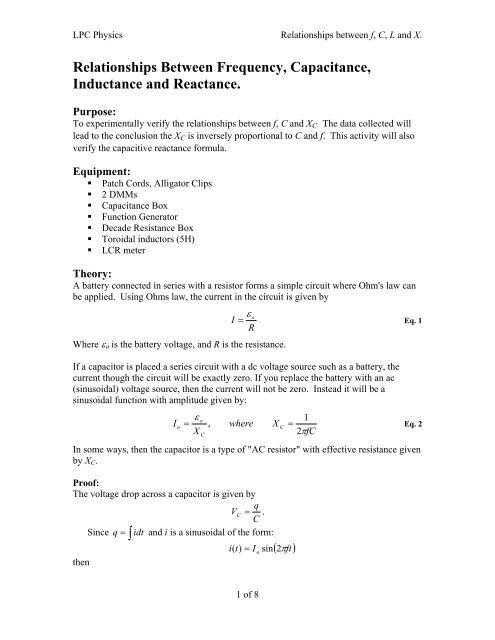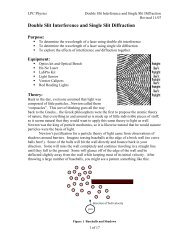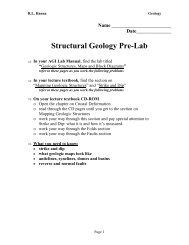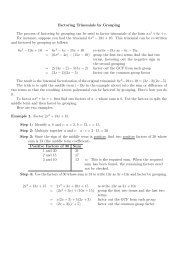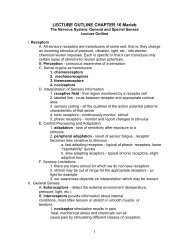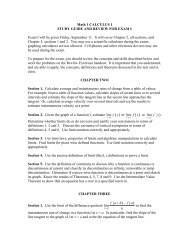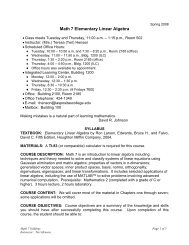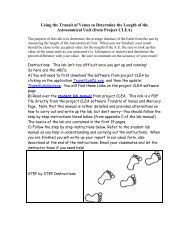Relationships between Frequency, Capacitance, Inductance and ...
Relationships between Frequency, Capacitance, Inductance and ...
Relationships between Frequency, Capacitance, Inductance and ...
Create successful ePaper yourself
Turn your PDF publications into a flip-book with our unique Google optimized e-Paper software.
LPC Physics <strong>Relationships</strong> <strong>between</strong> f, C, L <strong>and</strong> X.<br />
<strong>Relationships</strong> Between <strong>Frequency</strong>, <strong>Capacitance</strong>,<br />
<strong>Inductance</strong> <strong>and</strong> Reactance.<br />
Purpose:<br />
To experimentally verify the relationships <strong>between</strong> f, C <strong>and</strong> X C . The data collected will<br />
lead to the conclusion the X C is inversely proportional to C <strong>and</strong> f. This activity will also<br />
verify the capacitive reactance formula.<br />
Equipment:<br />
• Patch Cords, Alligator Clips<br />
• 2 DMMs<br />
• <strong>Capacitance</strong> Box<br />
• Function Generator<br />
• Decade Resistance Box<br />
• Toroidal inductors (5H)<br />
• LCR meter<br />
Theory:<br />
A battery connected in series with a resistor forms a simple circuit where Ohm's law can<br />
be applied. Using Ohms law, the current in the circuit is given by<br />
Where ε ο is the battery voltage, <strong>and</strong> R is the resistance.<br />
I<br />
ε o<br />
= Eq. 1<br />
If a capacitor is placed a series circuit with a dc voltage source such as a battery, the<br />
current though the circuit will be exactly zero. If you replace the battery with an ac<br />
(sinusoidal) voltage source, then the current will not be zero. Instead it will be a<br />
sinusoidal function with amplitude given by:<br />
I<br />
ε<br />
R<br />
1<br />
, where X<br />
C<br />
=<br />
2πfC<br />
o<br />
o<br />
= Eq. 2<br />
X<br />
C<br />
In some ways, then the capacitor is a type of "AC resistor" with effective resistance given<br />
by X C .<br />
Proof:<br />
The voltage drop across a capacitor is given by<br />
q<br />
V C<br />
= .<br />
C<br />
Since q = ∫ idt <strong>and</strong> i is a sinusoidal of the form:<br />
i( t)<br />
= I<br />
o<br />
sin 2πft<br />
then<br />
( )<br />
1 of 8
LPC Physics <strong>Relationships</strong> <strong>between</strong> f, C, L <strong>and</strong> X.<br />
I<br />
o<br />
q( t)<br />
= ∫ I<br />
o<br />
sin( 2 π ft) dt = cos( πft)<br />
2πf<br />
2<br />
thus Vc can be written as:<br />
I<br />
o<br />
VC<br />
= cos( 2πft) = VC<br />
cos( 2πft)<br />
.<br />
max<br />
2πfC<br />
We define the reactance of the capacitor as:<br />
Thus,<br />
this implies that we can calculate Xc by Eq. 3.<br />
X<br />
C<br />
VCmax<br />
X<br />
C<br />
= Eq. 3<br />
I<br />
max<br />
⎛ I<br />
o<br />
⎞ 1<br />
= ⎜ ⎟ I<br />
o<br />
=<br />
Eq. 4<br />
⎝ 2πfC<br />
⎠ 2πfC<br />
If an inductor is placed in a series circuit with a sinusoidal voltage supply, then the<br />
current is given by:<br />
ε<br />
o<br />
I<br />
o<br />
= where X<br />
L<br />
= 2πfL<br />
X<br />
L<br />
In the same way, an inductor can be considered an AC resistor, with effective resistance<br />
.<br />
X L<br />
Proof:<br />
The voltage drop across an inductor is given by<br />
di<br />
V L<br />
= L .<br />
dt<br />
If<br />
i( t)<br />
= I<br />
o<br />
sin( 2πft)<br />
,<br />
then<br />
VL<br />
= 2πfLI<br />
o<br />
cos 2πft<br />
<strong>and</strong> we can define the inductive resistance X L by:<br />
thus,<br />
X<br />
L<br />
max<br />
( )<br />
VL<br />
max<br />
X<br />
L<br />
= Eq. 5<br />
I<br />
2πfLI<br />
C<br />
= = 2πfL<br />
. Eq. 6<br />
I<br />
This implies that we can calculate Xc using Eq. 5 by measuring the voltage drop across<br />
the inductor <strong>and</strong> the current through the circuit. We can also calculate X L from Eq. 6 with<br />
knowledge of f <strong>and</strong> L.<br />
o<br />
2 of 8
LPC Physics <strong>Relationships</strong> <strong>between</strong> f, C, L <strong>and</strong> X.<br />
Experiment <strong>and</strong> Analysis:<br />
Part A<br />
1. a. Construct the circuit shown in Figure 1 below using a 1-µF capacitor for C 1 . Use<br />
the LCR meter to determine a "good" value for the capacitance. Next, set the<br />
generator frequency to approximately 100 Hz . Adjust the output control for<br />
approximately 1- 3 V across the capacitor. Record the current flowing through the<br />
capacitor.<br />
Note: you may have difficulty using the DMM meter to record the current! It is<br />
likely to be rather small. An alternative strategy is to set up the circuit as shown<br />
in Figure 2. The resistance should be on the order of 1 / 2πfC . You can then<br />
measure the voltage across the resistance box <strong>and</strong> divide by the resistance (I =<br />
V/R) to determine the current. Keep in mind that you must use figure (1) to<br />
measure the voltage across the capacitance, <strong>and</strong> figure (1b) to measure the<br />
voltage across the resistor. Also remember not to change the resistance when<br />
you measure voltage across the capacitor.<br />
Note that the DMM measures RMS values for current:<br />
I<br />
rms<br />
=<br />
(Essentially, this means that that I o = the DMM reading multiplied by 2 ).<br />
V<br />
DMM AC Voltage readings are also rms values, so that V =<br />
o<br />
.<br />
rms<br />
I o<br />
2<br />
2<br />
R<br />
Resistance<br />
Box<br />
Function<br />
generator<br />
+<br />
_<br />
~<br />
C<br />
Vc<br />
DMM set<br />
on AC<br />
volts.<br />
Figure 1 Measuring the Voltage with the DMM<br />
3 of 8
LPC Physics <strong>Relationships</strong> <strong>between</strong> f, C, L <strong>and</strong> X.<br />
C<br />
Function<br />
generator<br />
+<br />
_<br />
~<br />
R Resistance<br />
Box<br />
Vr<br />
DMM set<br />
on AC<br />
volts.<br />
Figure 2 Measuring the current using the resistance box.<br />
b. Using your measured current <strong>and</strong> voltage, compute the reactance of the capacitor<br />
using X C = V C /I C . You can use the DMM readings for V C <strong>and</strong> I C since the factor<br />
2 cancels out.<br />
c. Calculate the reactance using the reactance formula<br />
1<br />
X C<br />
= 2πfC<br />
d. Are the values computed in Steps 1b <strong>and</strong> 1c within 10 percent of each other? If<br />
not, use the LCR meter to get good values for the capacitance, <strong>and</strong> resistance. If<br />
they check out, then use the oscilloscope to determine the period <strong>and</strong> frequency of<br />
the function generator. Also be sure that you have a "good" sine wave. When you<br />
are satisfied, enter your results in Table 1.<br />
e . Do your results confirm the reactance formula (within the tolerances of the meter,<br />
the generator <strong>and</strong> the capacitor )? That is, does I C X C = V C ?<br />
2. a. Suppose the generator frequency is changed to 50 Hz while the voltage remains at<br />
3 V. What will happen to the reactance?<br />
b. What will happen to the circuit current?<br />
c. Change the generator frequency to 50 Hz <strong>and</strong> record the new current in Table 1.<br />
d. Does your answer to Step 2c support your answer to Step 2b?<br />
e. How much current would you expect if the frequency were changed to 200 Hz<br />
<strong>and</strong> V C remained at 3 V?<br />
f. Change the frequency to 200 Hz <strong>and</strong> adjust the generator for 3 V across the<br />
capacitor. Record the current.<br />
4 of 8
LPC Physics <strong>Relationships</strong> <strong>between</strong> f, C, L <strong>and</strong> X.<br />
3. Change the capacitor in Fig. 1 to 0.15 µF. Repeat Steps 1 <strong>and</strong> 2. Enter your results in<br />
Table I.<br />
4. Do your values for V C <strong>and</strong> I C X C agree in each case? If not, is the agreement better<br />
at high or low frequencies? Why do you think this is?<br />
Part B<br />
1. Repeat the procedure from Part 1 using the 5H inductor in place of the capacitor.<br />
Use the LCR meter to get a "good" value for inductance. Complete Table 2 using<br />
Eqs. 5 <strong>and</strong> 6. Your values for X L should agree within 10 or 15% (due to<br />
uncertainties in measuring AC current accurately). If you are using the resistance<br />
box to determine current, you will have to change the setting so that enough<br />
voltage is dropped across it to be measured. In general, set R box approximately<br />
equal to 2πfL for whatever frequency you are using.<br />
A<br />
DMM on<br />
AC current<br />
setting<br />
Function<br />
generator<br />
+<br />
~<br />
-<br />
L<br />
Vc<br />
DMM set<br />
on AC<br />
volts.<br />
Figure 3<br />
2. Check to see if the reactance determined above agrees with the value calculated by<br />
the reactance formula. Calculate <strong>and</strong> record the reactance using the formula<br />
X L = 2πfL. The reactance calculated here should be within 15% of the reactance<br />
you listed in Table 2. If it is not, recheck your measurements <strong>and</strong> your<br />
calculations.<br />
3. Change the frequency of the generator to 500 Hz. Measure the output voltage of<br />
the generator. Note that the output voltage is likely to drop. Make the<br />
measurements <strong>and</strong> calculation necessary to complete the second row of the table.<br />
Does your data table support your predictions about what happens to the reactance<br />
<strong>and</strong> the current?<br />
5 of 8
LPC Physics <strong>Relationships</strong> <strong>between</strong> f, C, L <strong>and</strong> X.<br />
4. Change the generator frequency to 1000 Hz. From the reactance you determined<br />
in the first two rows of Table 2, predict <strong>and</strong> record the reactance you will have at<br />
1000 Hz. Complete the third row of the table to check your prediction.<br />
Results:<br />
Write at least one paragraph describing the following:<br />
• what you expected to learn about the lab (i.e. what was the reason for conducting<br />
the experiment?)<br />
• your results, <strong>and</strong> what you learned from them<br />
• Think of at least one other experiment might you perform to verify these results<br />
• Think of at least one new question or problem that could be answered with the<br />
physics you have learned in this laboratory, or be extrapolated from the ideas in<br />
this laboratory.<br />
6 of 8
LPC Physics <strong>Relationships</strong> <strong>between</strong> f, C, L <strong>and</strong> X.<br />
Clean-Up:<br />
Before you can leave the classroom, you must clean up your equipment, <strong>and</strong> have your<br />
instructor sign below. How you divide clean-up duties <strong>between</strong> lab members is up to you.<br />
Clean-up involves:<br />
• Completely dismantling the experimental setup<br />
• Removing tape from anything you put tape on<br />
• Drying-off any wet equipment<br />
• Putting away equipment in proper boxes (if applicable)<br />
• Returning equipment to proper cabinets, or to the cart at the front of the room<br />
• Throwing away pieces of string, paper, <strong>and</strong> other detritus (i.e. your water bottles)<br />
• Shutting down the computer<br />
• Anything else that needs to be done to return the room to its pristine, pre lab form.<br />
I certify that the equipment used by ________________________ has been cleaned up.<br />
(student’s name)<br />
______________________________ , _______________.<br />
(instructor’s name)<br />
(date)<br />
7 of 8
LPC Physics <strong>Relationships</strong> <strong>between</strong> f, C, L <strong>and</strong> X.<br />
TABLE 1<br />
C I C V C f X c (theory) X c (exp) %diff<br />
50<br />
100<br />
200<br />
400<br />
<strong>Frequency</strong><br />
f<br />
Current<br />
I<br />
Voltage<br />
across L 1,<br />
V<br />
L 1<br />
(measured)<br />
TABLE 2<br />
Inductive<br />
Reactance<br />
X L<br />
= 2πfL<br />
Inductive<br />
reactance %<br />
VL<br />
X = difference<br />
L<br />
I<br />
100 Hz<br />
500 Hz<br />
1000 Hz<br />
8 of 8


